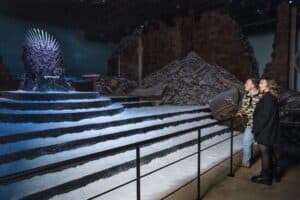The act of storytelling is an iconic part of Celtic culture. The lands of the druids, Celts and high kings remain compelling for many reasons. One of those is these stories which have been passed down for generations. They give us a better understanding of the people, their values and the land in which they lived.
 1. Children of Lir
1. Children of LirThis is one of the sadder Irish mythology stories spanning from the post-Christianization period mixing magic and religion. The lives of four children are changed forever when their stepmother Aoife turns them into swans. She does this out of jealousy of the love their father, Lir, has for them. The curse condemns them to live on water for nine hundred years before they can regain their human form. At the end of nine hundred years, the children are finally allowed to come to shore – but they are children no more. Ancient and shriveled, they set foot on land again, only to die and find peace at last. This tale is said to bring a message of freedom.
 2. Oisin in the Land of Tir na nÓg
2. Oisin in the Land of Tir na nÓg
In this Celtic legend, a warrior named Oisin is persuaded to come to the land of the ever-young by a beautiful goddess, Niamh. This land is also referred to as ‘Tir na nÓg’. Its residents never grow old or die, and there is feasting and music every day.
Oisin enjoys his time there, but then he begins to miss his friends and family in Ireland. He goes to see Niamh and tells her he wants to return to them. She gives him a white horse to take him back to Ireland. There is a bit of a catch, however. She warns him he must not get down from the horse under any circumstances.
Oisin agrees to this and makes the journey home. He’s in for the ultimate shock when he learns he has been away for hundreds of years. Everyone Oisin knew has long since died and the land has changed. While pondering this sad truth, he sees a man trying to roll a large stone out of a field. It’s then Oisin leans down from his horse to help him move the stone. In this pivotal moment, the strap around his saddle snaps and Oisin falls to the ground. In an instant, hundreds of years of time catch up with Oisin, and he turns to dust.
This story has been interpreted in many ways. An overall theme is aging naturally, and that eternal youth may have a darker side.
Sadly Tír na nÓg does not exist but some would say there are certain parts of Ireland that come close to it!

3. Leprechauns
This list wouldn’t be complete without Ireland’s mythical, iconic leprechauns. They’re famous all over the world, especially on St Patrick’s Day. These sprite-like characters feature in legends, myths and tales and in many of these tales they are portrayed as mischievous and untrustworthy characters. Some believe that the name leprechaun derives from the word ‘leath bhrogan‘, which translates to shoemaker and is supposedly the leprechaun’s main vocation. Leprechauns are famously known to store a pot of gold that is hidden at the end of the rainbow. On a journey across Ireland, you’re guaranteed to spot a statue or picture of a leprechaun. If you squint long and hard enough among the clover fields, perhaps you’ll even catch a glimpse of one hiding there, too.
According to legend, if captured by a human, the leprechaun will grant three wishes in exchange for their freedom. In their spare time, leprechauns are said to fix shoes and they wear suites of green with a top hat and beard.The modern-day depiction of a Leprechaun is that of a man clad entirely in green. However, Irish folklore describes Leprechauns as men who wore red outfits and tri-cornered hats.
Did you know that leprechauns are actually a protected species under EU law? Carlingford’s Sliabh Foy Loop trail is officially protected land for the 236 Leprechauns that apparently live in Ireland.
 4. Salmon of Knowledge
4. Salmon of Knowledge
This tale starts out with a young man named Fionn Mac Cumhaill. He was sent to live with a wise man in Ireland named Finnegas who was a poet. Fionn helped Finnegas any way he could with chores in exchange for his knowledge. The wise and intelligent Finnegas lived off the River Boyne. Locals claimed a certain salmon lived in the river who ate magical hazel nuts which gave him all the knowledge of the world. According to legend, anyone who found the salmon and ate it would gain that knowledge for themselves. This is why Finnegas, who was already wise, lived by the river. He hoped to catch the salmon and receive even more knowledge.
After seven years of working together, the men caught and cooked the fish. Finnegas warned Fionn not to eat it, but when cooking the fish, he got its oil on his thumb and licked it off. As a result, Fionn gained the knowledge of the world and became the leader of The Fianna (a type of warrior). Today, a sculpture of the salmon is located in Belfast.





